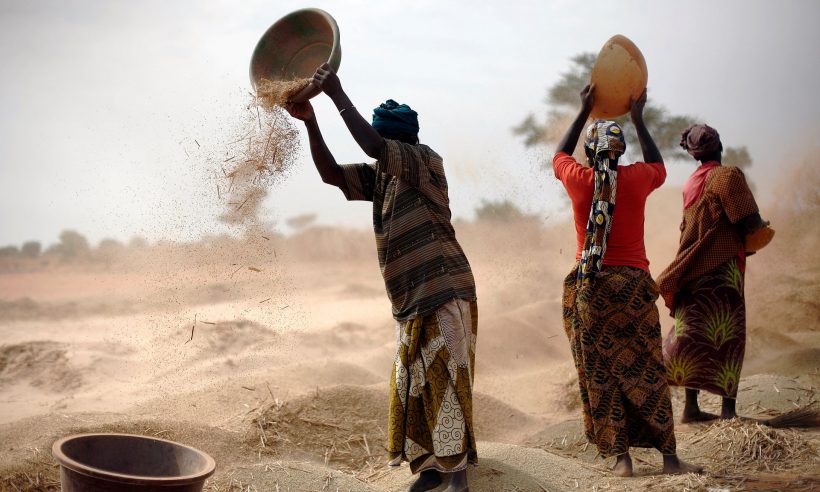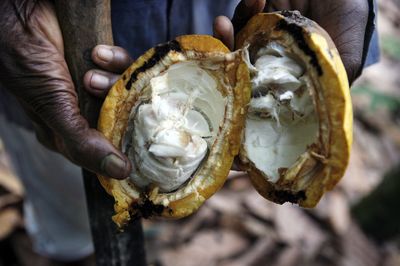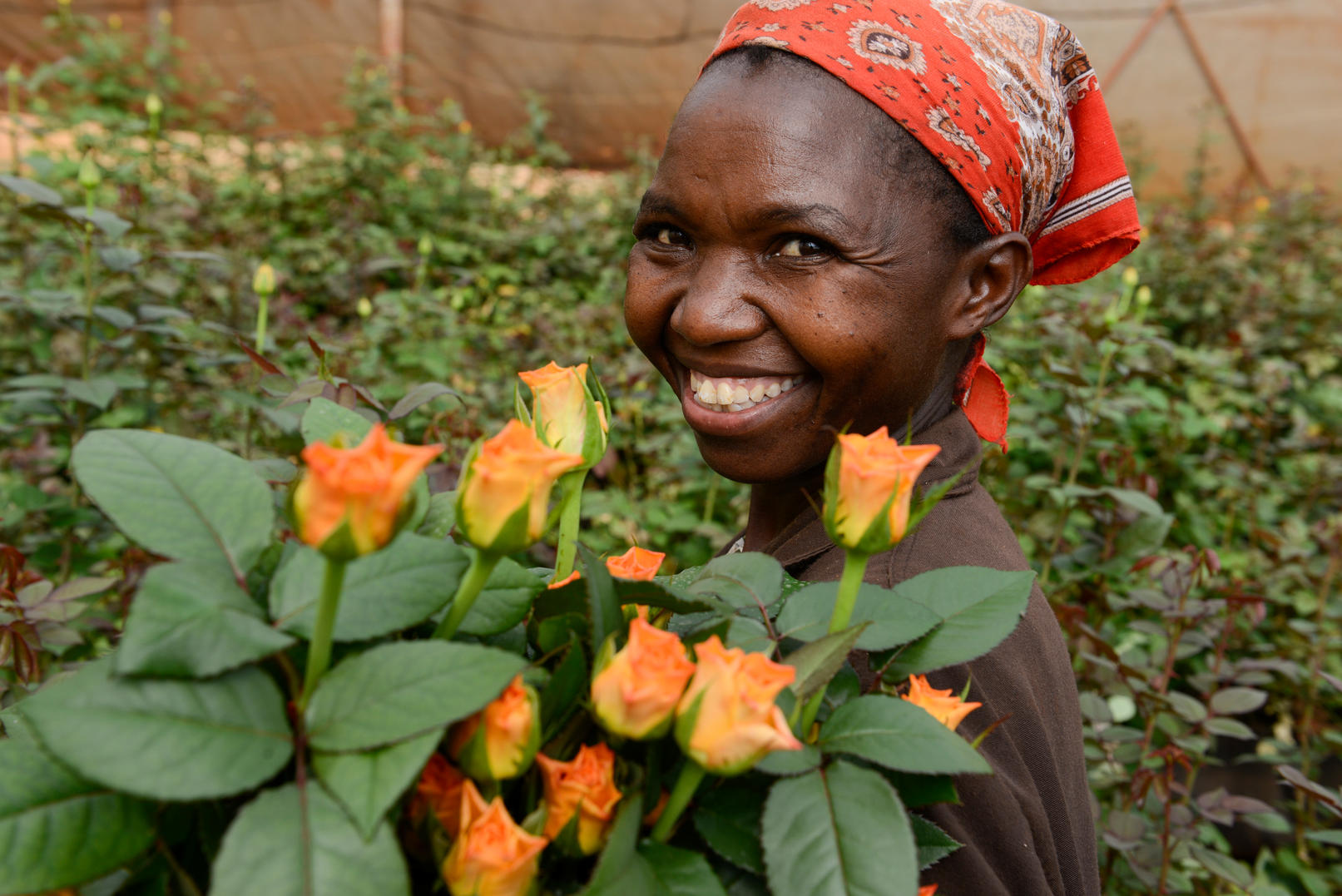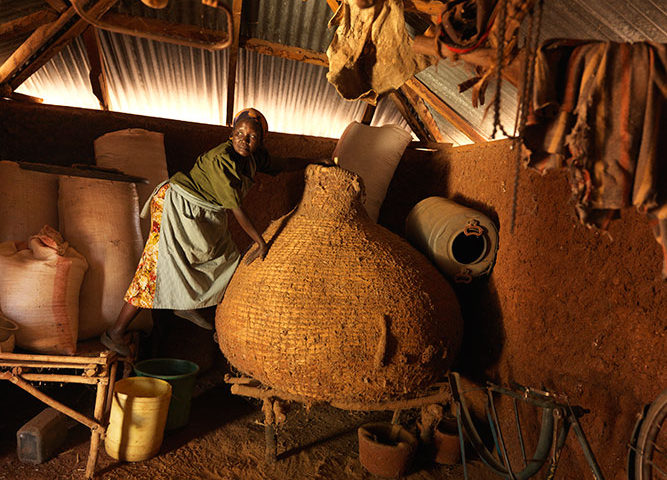This contribution draws on time spent interviewing, walking with villagers and witnessing the eroding base of women’s security and empowerment in rural and informal sectors in some African countries, a trend that has heightened in the last decade.

Photograph: Jerome Delay/AP
The countries in question share some common features: a colonial legacy of peoples displaced from their ancestral lands; vast and valuable natural resources; high illiteracy rates among rural populations; patchy rural infrastructure; the vestiges of weakened traditional accountability systems; and investment policies that significantly favour the industrial commodity chain [*] over peasant-based food sovereignty.
Rural women in these arenas are caught up in extremely challenging situations of feeding and providing for their families today while trying to plan for the future – a future fraught with unknowns. The narratives and experiences from women in Uganda, Tanzania, Malawi, Mozambique, Zambia, Zimbabwe, Ghana and Liberia all echo and reverberate to a common strain – their struggles are intensifying, their opportunities are limited and they are close to breaking point as their relationships with land, water, with natural capital [[1]] and with the public commons are weakened on multiple fronts.
Women want their roles dignified, valued, recognised and supported. Where women are able to articulate their interests, or when their values and priorities are incorporated into policy-making and planning, more compelling demands are made for longer-term and holistic outcomes around health, education, food security and overall well-being for the community as a whole. In many senses, these are the bedrock factors of sustainable economies. Relative to men, women’s immediate interests in these public services are especially high.
That said, rural women are by no means a homogeneous group. Some women are so disenfranchised, having no say in the decisions that affect their lives, that they will settle for hourly labour within the globalised production system at any price. In more desperate circumstances, they will rely on humanitarian and community assistance. A growing number of women and women’s networks, however, are standing up to protect their version of sustainable or natural economies; their rights to public spaces; to seed, forest and water; to health, nutrition and secure food sources, despite the increasingly tenuous situations that they may find themselves in.
More often than not, they are pushed to a point where they are prepared to lay their bodies on the line to prevent further displacement and disempowerment, at great personal risk. They are the “shoot me first” constituency. Unregulated consumption, population growth, the commercialisation and privatisation of land and water, and a compromised political leadership that cares less about women, all serve to heighten the stakes.
Between a rock and a hard place
Liberia has one of the highest land concession rates on the continent. The government of Liberia has a range of policies and laws for the community management of natural resources and has signed up to related international agreements. The concentration of plantation and mining interests is extremely high; one 2012 report puts the total land allocated to rubber, oil palm and forestry concessions at approximately 25 percent of the country. [[2]] A series of recent studies warn that agro-investments [[3]] in Liberia have not met the expectations of the communities. Some communities have lost access to land resources and their food security in the process. [[4]]

Photographer: JANE HAHN/Bloomberg
Asia’s leading companies in the palm oil industry, especially from Indonesia and Malaysia, are turning their attention to Africa. On paper, palm oil companies have access to over 622,000 hectares and an average market capitalisation of US $8.2 billion in Liberia.
[[5]] There are four main concession agreements at the moment with a total investment of about US $2.56 billion. If the agreement with Sime Darby to plant on 220,000 hectares goes ahead, then this is more than the total land area that the company had planted in Indonesia in 2009 and ten times more than the total area of oil palm plantations established in Ghana.
[[6]] This gives a sense of scale to plantation expansion in Liberia.
Traditionally, palm oil [[7]] is primarily a woman’s crop; it ceases to be so once it enters the global supply chain. In the domestic markets across the West African region, women are the majority stakeholders in a thriving local supply chain in palm oil processing, palm fruit marketing and palm kernel processing and marketing. On the international market palm oil is increasingly traded as feedstock for biofuel although its primary use is for human consumption.
If community engagement around land use decisions is not integrated systemically into government policy, the resulting societal tensions could be trigger points for local grievances, conflict and violence. The long-term implications of losing land and dignity are well documented and the particular impacts for rural women are acknowledged by the international community. [[8]]
At the same time, with costs of living rising, the need to earn becomes more pressing. Faced with few options, and with the reality of their low employment marketability, women and men in rural communities will look to new rural investments with some expectation of employment, infrastructure development and service provision. In one palm oil plantation nursery, women are engaged in short-term seasonal work to bag, weed and administer chemicals to the palm saplings for the equivalent of US $5 a day. In Malema town, none of the women interviewed worked on the plantation. They farmed on the fringes of the plantation, supplementing their needs with charcoal burning, and had relinquished farmland to the plantation.
Rural women in Liberia already play significant roles in managing natural resources for their food, fuel, shelter and water needs. They have central and multiple relationships with natural resources that are core to their day-to-day livelihoods. They might not recognise the value of this management function themselves, and they might not be drawing the links between their farming practices, deforestation and long-term water sources. Yet on a day-to-day basis, they fulfil a wide range of activities that are directly linked to natural resource management. Asked to describe their relationships with natural resources, women invariably talk about these activities and are less likely to refer to their extractive (aggregates and mining) activities, as these activities are driven by market demand and the need to supplement income [[9]]. Artisanal mining continues to be a critical aspect of resource extraction in this country, requiring gender-specific policies, because of the non-formal and highly exploitative nature of the sector.

When it comes to the formal commercialisation of natural resource extraction, women’s involvement becomes invisible and is put at risk, primarily because women do not have control over the decisions taken on land and natural resource access and use. Their relationship with the production and processing of these natural resources is reduced to a purely transactional one. In the process of commercialisation of these resources, women and their productive activities are invariably pushed out to marginal lands – where the environmental impacts on the physical environment can be especially taxing.
Entry points for policy intervention and regulation
Using the UN System of Integrated Environmental and Economic Accounts as a basis to categorise and analyse natural resources (Figure below), four areas emerge for policy development.
Public commons
Most of the country’s water, land and air are held as community property in the public commons, with distribution of natural resources traditionally governed by male elders in the non-formal economy. Women access these resources for energy, home construction and for income.
Food security
The circles superimposed on the figure highlight those natural resources that underpin formal and non-formal rural economies. The substantive basis for food security lies in agriculture, forestry and coastal and inland fishery, whose day-to-day management is predominantly undertaken by women.
Extractive activities
The extraction of non-renewable metal ores in the non-formal sector, artisanal small-scale mining (ASM) and plantation businesses all rely heavily on the support roles of women. The benefits they derive from these activities, however, remain largely peripheral.
Non-renewable materials
As the commercial exploitation of land and non-renewable abiotic materials intensifies, women’s access to the public commons and to biotic materials in the non-formal (communal) sector needs protection and strengthening, while enabling women to take engaged positions in the formal (private) sector.
Roadside markets showed a “vibrant self-employment” informal economy based on the exploitation of natural resources. Neatly tied bundles of bamboo, wood and thatch for construction, sacks of charcoal, piles of rock and slate broken into different sizes, piles of wood for burning and hills of sand of various gradients speak to an entrepreneurial drive or need to earn cash. It is not clear what implications this may have for the natural environment from which these items are extracted, whether this is regulated in any way, or whether there should even be any control over these public commons. While these existing natural resources are community assets, a question needs to be raised about the replacement value of these assets and whether there are other, more sustainable alternatives to be considered as sources of income for the poor. The entrepreneurial spirit and drive need to be complemented by awareness and action to replace and regenerate what is being mined.
Empowering women to reclaim and advance community assets and rights

With population growth, competition for natural resources and growing inequalities, the empowerment of rural women needs to take place on multiple fronts. In the case of rural women, this will mean wresting back power to take control over the decisions that affect their domestic household security, in their informal and communal (public commons) spaces as well as in the formal and political arenas.
Policies that promote women’s empowerment tend to lean towards “economic empowerment”, the assumption being that with expanded economic means come more and better choices. The more financial leverage one has, the more likely one is to project power: gain voice, respect, independence and the ability to negotiate terms and a more favourable hearing. In reality, in the course of earning income in mines, plantations or in the informal natural resource economy, women are systematically exploited, have decision-making choices taken away from them and are left with denuded natural environs – a heavy price to pay for so-called empowerment.
The empowerment goal will need to be to strengthen not only women’s daily management roles, but also their capacity for directly engaging in community decisions around (i) how natural resources are developed, (ii) how the benefits from extraction of natural resources are fairly shared over time, and (iii) how they might themselves engage in supply chains. Given their societal status and relative lack of assets, women are more likely to lead change as a group than as individuals. They will need to build networks of solidarity with community members across gender barriers to articulate and act on collective interests. This becomes especially difficult in rural areas, where villages are relatively isolated from each other and where transport is a significant and expensive challenge.
Women’s relationships with natural resources require transformative change to current practices and policies that discriminate against or undervalue women and their productive activities. Some fundamental bases for change include:
Correcting gender imbalances in landholding and use through deconstructing, reconstructing and reconceptualising existing rules of property in land under both customary and statutory laws in ways that strengthen women’s access to and control of land while respecting family and other social networks. [[10]]
Empowerment within the holistic agro-ecological farming framework – integrating organic farming practices with food security and natural resource management through changing the mode of farm practice to a holistic agro-ecological system, including tried and tested models such as organic and permaculture farming which will integrate community management of natural resources with their food production activities. [[11]]
Enhancing the proactive contribution of women in defining and implementing alternative solutions to their local fuel needs, shifting towards clean and renewable energy systems.
Supporting the mobilisation, political consciousness and organisation of rural and urban women to improve their situation, influence policy and realise their rights – at decentralised, local, national and political levels.
Raising public awareness about rights and access to natural resources as both a public service and a civil rights issue.
From patriarchal traditions to gender-sensitive common regimes
Now more than ever, poor women and men must claim their rights of access to natural capital within the framework and cultural context of common property, community rights and community responsibilities and solidarity.
As in many African countries, the traditional management of forest landscapes in Liberia is made up of a complex hierarchy of gender relationships, knowledge and customs.
An adult male “bush manager” is appointed by the elders to manage access to forest resources, covering a number of villages, to prevent the over-exploitation of these resources. Women are not part of this group of elders, the suggested reason being that women are “afraid” to make decisions and because they are excluded by the male secret society. Most sacred groves of the male secret societies [[12]] are associated with forests, with strong oversight by members.
Taboos and sanctions prohibit the exploitation of forest resources for commercial gain. When it comes to land access, both men and women have equal rights to private ownership of the flood plains for sugar cane production, although capital availability limits women’s investment relative to men. [[13]] With the demise of these local and hierarchical structures – through changing political space and the influence of Christian and Islamic teachings – this kind of localised forest conservation service is in decline. [[14]]
How can the appropriate aspects of traditional value systems that policed community use of natural resources be adapted to a gender-sensitive application of rules and procedures that empowers men and women in these communities? How can the empowerment of women within the collective framework secure their rights to natural resources? How can rural communities that sustained a non-formal rural economy be supported as they enter unmediated agreements in the formal economy that expose them to the risks of global markets?
These are questions that need to be addressed.
One response is offered by the Nobel laureate Elinor Ostrom, who argued that economic activity could be effectively regulated by collective social activity. [[15]] She applied the term Common Pool Regimes (CPRs) to categorise such forms of property. Her findings documented that collective community ownership of resources by rural communities may foster the evolution and adaptation of sustainable resource systems (or regimes).
Along with clear rights and functioning policies for public goods and the commons, fostering collective rights to common property helps to secure the future provision of ecosystem services. Ostrom challenged the assumption that common property is poorly managed unless regulated by government or privatised, and proved that individuals can successfully form collectives that protect the resource at hand. This way of thinking sits at the heart of the way pastoralists and rural women might measure the value of natural capital – where the idea of private ownership of part or all of an ecosystem runs counter to communal access to, and stewardship of, the biosphere.
The Organisation for Economic Cooperation and Development Development Assistance Committee, the World Bank and international non-governmental organisations are renewing their focus on access to natural resources as a core component of poor rural people’s entitlements as citizens.
Natural resources management and agriculture knowledge, technology and public services are of key importance to support natural-resource-based livelihoods, particularly in the face of environmental, climatic and market changes that require new solutions and adaptation. [[16]] These new solutions, behavioural changes and adaptive practices will need in the first instance to consider how women can be empowered to be community architects for the future.

